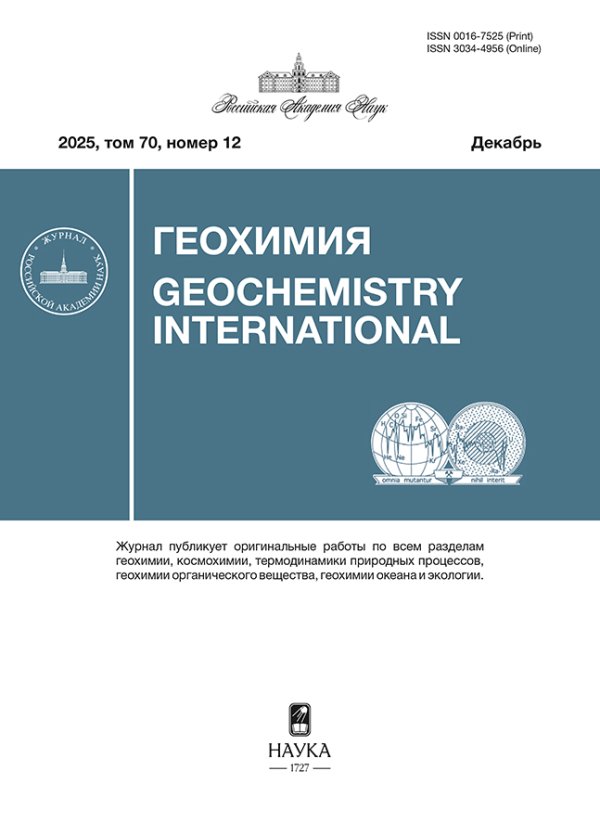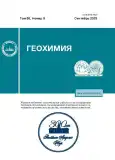HYDROCARBONS IN LITTORAL SEDIMENTS AND MARCH SOILS OF THE SOUTHWESTERN COAST OF THE BARENTS SEA
- Authors: Kursheva A.V.1, Morgunova I.P.1, Petrova V.I.1, Litvinenko I.V.1,2
-
Affiliations:
- Federal State Budgetary Institution “Academician I. S. Gramberg All-Russia Scientific Research Institute for Geology and Mineral Resources of the Ocean” (FSBI “VNIIOkeangeologia”)
- St.Petersburg State University, Institute of Earth Sciences
- Issue: Vol 68, No 9 (2023)
- Pages: 964-981
- Section: Articles
- URL: https://journals.rcsi.science/0016-7525/article/view/134833
- DOI: https://doi.org/10.31857/S0016752523090078
- EDN: https://elibrary.ru/WNYHYE
- ID: 134833
Cite item
Full Text
Abstract
According to the results of GC-MS study of the composition and distribution of hydrocarbons (n-alkanes, isoprenoids, steranes, hopanes, polycyclic aromatic hydrocarbons (PAHs) and their alkyl homologues), the genesis, facies conditions of sedimentation, the degree of transformation of organic matter of bottom sediments and marching soils of the southwestern coast of the Barents Sea are characterized. The assessment of the toxicity levels of polyarenes on the biota inhabiting the tidal zones of the coast was carried out. Areas with increased anthropogenic load have been identified (littoral of the eastern Tana Fjord, the village of Kiberg, Abram Cape, the village of Mishukovo, the mouth of the Kulonga River, the apex part of the Yarnyshnaya Bay, Oscar Bay), indicating the unfavorable ecological state of the tidal zones of the Barents Sea coast.
Keywords
About the authors
A. V. Kursheva
Federal State Budgetary Institution “Academician I. S. Gramberg All-Russia Scientific Research Institute for Geology and Mineral Resources of the Ocean”(FSBI “VNIIOkeangeologia”)
Email: A.Kursheva@mail.ru
190121, Angliyskiy Av., 1, Saint-Petersburg, Russia
I. P. Morgunova
Federal State Budgetary Institution “Academician I. S. Gramberg All-Russia Scientific Research Institute for Geology and Mineral Resources of the Ocean”(FSBI “VNIIOkeangeologia”)
Email: A.Kursheva@mail.ru
190121, Angliyskiy Av., 1, Saint-Petersburg, Russia
V. I. Petrova
Federal State Budgetary Institution “Academician I. S. Gramberg All-Russia Scientific Research Institute for Geology and Mineral Resources of the Ocean”(FSBI “VNIIOkeangeologia”)
Email: A.Kursheva@mail.ru
190121, Angliyskiy Av., 1, Saint-Petersburg, Russia
I. V. Litvinenko
Federal State Budgetary Institution “Academician I. S. Gramberg All-Russia Scientific Research Institute for Geology and Mineral Resources of the Ocean”(FSBI “VNIIOkeangeologia”); St.Petersburg State University, Institute of Earth Sciences
Author for correspondence.
Email: A.Kursheva@mail.ru
190121, Angliyskiy Av., 1, Saint-Petersburg, Russia; 199034, Universitetskaya Emb., 7-9, Saint-Petersburg, Russia
References
- Айбулатов Н.А. (2005) Деятельность России в прибрежной зоне моря и проблемы экологии. М.: Наука, 363 с.
- Баженова О.К., Бурлин Ю.К., Соколов Б.А., Хаин В.Е. (2000) Геология и геохимия нефти и газа. М.: Изд-во МГУ, 384 с.
- Вассоевич Н.Б. (1958) Образование нефти в терригенных отложениях (на примере чокракско-караганских слоев Терского передового прогиба). В кн.: Вопросы образования нефти. Л.: Гостоптехиздат, Тр. ВНИГРИ. 128, 9-22.
- Вассоевич Н.Б. (1973) Природа органического вещества современных и ископаемых осадков. М.: Наука, 261 с.
- Гордадзе Г.Н. (2015) Углеводороды в нефтяной геохимии. Теория и практика. М.: Российский государственный университет нефти и газа им. И.М. Губкина. 559 с.
- Данюшевская А.И., Петрова В.И., Яшин Д.С., Батова Г.И., Артемьев В.Е. (1990) Органическое вещество донных отложений полярных зон Мирового океана. Л.: Недра, 280 с.
- Жилин А.Ю., Плотицина Н.Ф. (2009) Состав, источники и токсикологический потенциал ПАУ в донных осадках Кольского залива Баренцева моря. Известия ТИНРО. 156, 247-253.
- Каширцев В.А. (2003) Органическая геохимия нафтидов востока Сибирской платформы. Я.: СО РАН, 160 с.
- Кирюхина Н.М. (2013) Нефтегазогенерационный потенциал юрских отложений шельфа Баренцева моря: Автореф. дис. … канд. геол.-мин. наук. Москва: Московский государственный университет им. М.В. Ломоносова, 23 с.
- Лейн А.Ю., Маккавеев П.Н., Саввичев А.С., Кравчишина М.Д., Беляев Н.А., Дара О.М., Поняев М.С., Захарова Е.Е., Розанов А.Г., Иванов М.В., Флинт М.В. (2013) Процессы трансформации взвеси в осадок Карского моря. Океанология. 53(5), 643-679.
- Немировская И.А. (2013) Нефть в океане (загрязнение и природные потоки). М.: Научный мир, 432 с.
- Панов Д.Г. (1940) Геологическая структура Баренцева моря в связи с морфологией его берегов. Ученые записки МГУ. Серия География. 48, 75-112.
- Патин С.А. (2017) Нефть и экология континентального шельфа. Том 2: Экологические последствия, мониторинг и регулирование при освоении углеводородных ресурсов шельфа. М.: ВНИРО, 284 с.
- Петров А.А. (1984) Углеводороды нефти. М.: Наука, 263 с.
- Петров А.А. (1994a) Биометки и геохимические условия образования нефтей России. Геология нефти и газа. 6, 13-19.
- Петрова В.И., Батова Г.И., Куршева А.В. (2009) Органо-геохимические исследования донных осадков в районах нефтедобычи (на примере шельфовой зоны о. Колгуев, Печорское море). Проблемы Арктики и Антарктики. 2(82), 60-67.
- Петрова В.И., Батова Г.И., Куршева А.В., Литвиненко И.В., Моргунова И.П. (2017) Молекулярная геохимия органического вещества триасовых пород северо-восточной части Баренцева моря – влияние тектонических и магматических процессов. Геология и геофизика. 58(3–4), 398-409.
- Ровинский Ф.Я., Теплицкая Т.А., Алексеева А.Д. (1988) Фоновый мониторинг полициклических ароматических углеводородов. Л.: Гидрометеоиздат, 224 с.
- Романкевич Е.А. (1977) Геохимия органического вещества в океане. М.: Наука, 256 с.
- Соснин Д.А., Куранов Ю.Ф. (2018) Мурманский морской транспортный узел сегодня и в перспективе. Кольский залив и нефть (биота, карты уязвимости загрязнение). (Под ред. Шавыкина А.А.). СПб.: Реноме, 520 с.
- Тарасов Г.А., Алексеев В.В. (1985) К осадкообразованию на шельфе южной части Баренцева моря. Геология и геоморфология шельфов и материковых склонов. М.: Наука, 112-117.
- Успенский В.А. (1970) Введение в геохимию нефти. Л.: Недра, 309 с.
- Alexander R., Fisher S.J., Kagi R.I. (1988) 2, 3-Dimethylbiphenyl: kinetics of its cyclisation reaction and effects of maturation upon its relative concentration in sediments. Org. Geochem. 13, 833-837.
- AMAP (1997) Assessment Report: Arctic pollution Issues: A State of the Arctic Environment Report. Oslo, Norway, 188 p.
- AMAP (2010) Assessment 2007: Oil and gas activities in the Arctic – Effects and potential effects, 2. In: Arctic Monitoring and Assessment Programme (AMAP), Oslo, Norway, 277 p.
- Bambulyak A., Frantzen, B., Rautio R. (2015) Oil transport from the Russian part of the Barents region. Status Report. The Norwegian Barents Secretariat and Akvaplan-niva, Norway, 105 p.
- Boitsov S., Jensen H.K.B., Klungsøyr J. (2009) Natural background and anthropogenic inputs of polycyclic aromatic hydrocarbons (PAH) in sediments of South-Western Barents Sea, Mar. Environ. Res. 68(5), 236-245.
- Boitsov S., Klungsøyr J., Jensen H. (2020) Background concentrations of polycyclic aromatic hydrocarbons (PAHs) in deep core sediments from the Norwegian Sea and the Barents Sea: a proposed update of the OSPAR commission background values for these sea areas. Chemosph. 251, 1-12.
- Bouloubassi I., Saliot A. (1993b) Investigation of anthropogenic and natural organic inputs in estuarine sediments using hydrocarbon markers (NAH, LAB, PAH). Oceanol. Acta 16, 145-161.
- Connan J., Cassou A. (1980) Properties of gases and petroleum liquids derived from terrestrial kerogen at various maturation level. Geochim. Cosmochim. Acta. 44(1), 10-23.
- Dahle S., Savinov V., Petrova V., Klungsøyr J., Savinova T., Batova G., Kursheva A. (2006) Polycyclic aromatic hydrocarbons (PAHs) in Norwegian and Russian Arctic marine sediments: concentrations, geographical distribution and sources. Norw. J. Geol. 86(1), 41-50.
- Dahle S., Savinov V., Klungsøyr J., Boitsov S., Plotitsyna N., Zhilin A., Savinova T., Petrova V. (2009) Polyaromatic hydrocarbons (PAHs) in the Barents Sea sediments: small changes over the recent 10 years. Mar. Biol. Res. 5, 101-108.
- Eglinton G., Murphy M.T.J. (1969) Organic geochemistry. Springer-Verlag, Berlin Heidelberg, New York, 828 p.
- Garrigues P., De Sury R., Angelin M.L., Bellocq J., Oudin J.L., Ewald M. (1988) Relation of the methylated aromatic hydrocarbon distribution pattern to the maturity of organic matter in ancient sediments from the Mahakam delta. Geochim. Cosmochim. Acta. 52, 375-384.
- George S.C., Volk H., Dutkiewicz A., Ridley J., Buick R. (2008) Preservation of hydrocarbons and biomarkers in oil trapped inside fluid inclusions for >2 billion years. Geochim. Cosmochim. Acta. 72, 844-870.
- Honda M., Suzuki N. (2020) Toxicities of Polycyclic Aromatic Hydrocarbons for Aquatic Animals. J Environ Res Public Health. 17(4), 1363.
- Hossain H.M.Z., Sampei Y., Hossain Q.H., Roser B.P., Sultan-Ul-Islam, M.D. (2013) Characterization of alkyl phenanthrene distributions in Permian Gondwana coals and coaly shales from the Barapukuria Basin, NW Bangladesh. Organ. Geochem. 29, 17-28.
- Keith L.H. (2015) The source of U.S. EPA’s sixteen PAH priority pollutants. Polycycl. Aromat. Compd. 35, 147-160.
- Kostyreva E.A., Kashirtsev V.A., Moskvin V.I., Bukin S.V., Khabuev A.V. (2019) Organic matter of bottom sediments from the zone hydrothermal activity (Frolikha Bay, North Baykal). SSUGT: Novosibirsk, Russia. 2, 81-86.
- Long E.R., MacDonald D.D., Smith S.L., Calder F.D. (1995) Incidence of adverse biological effects within ranges of chemical concentrations in marine and estuarine sediments. Environ. Manag. 19(1), 81-97.
- MacDonald D.D., Ingersoll C.G., Smorong D.E., Lindskoog R.A. (2003) Development and Applications of Sediment Quality Criteria for Managing Contaminated Sediment in British Columbia. MacDonald Environ. Scienc. Ltd. &US Geological Survey, 112 p.
- Meyer W., Seiler T.-B., Christ A., Redelstein R., Püttmann W., Hollert H., Achten C. (2014) Mutagenicity, dioxin-like activity and bioaccumulation of alkylated picene and chrysene derivatives in a German lignite. Sci. Total Environ. 497–498, 634-641.
- Morgunova I.P., Petrova V.I., Litvinenko I.V., Kursheva A.V., Batova G.I., Renaud P. E., Granovitch A.I. (2019) Hydrocarbon molecular markers in the Holocene bottom sediments of the Barents Sea as indicators of natural and anthropogenic impacts. Mar. Pollut. Bull. 149, 1-12.
- Morgunova I.P., Kursheva A.V., Petrova V.I., Litvinenko I.V., Batova G.I., Renaud P.E., Maltseva A.L., Granovitch A.I. (2021) Natural and anthropogenic organic matter inputs to intertidal deposits of the urbanized Arctic region: A multi-proxy approach. Marine Chemistry. 234(104001).
- Morgunova I., Semenov P., Kursheva A., Litvinenko I., Malyshev S., Bukin S., Khlystov O., Pavlova O., Zemskaya T., Krylov A. (2022) Molecular indicators of sources and biodegradation of organic matter in sediments of fluid discharge zones of Lake Baikal. Geosciences. 12(2), 72.
- Nisbet C. and LaGoy P. (1992) Toxic Equivalency Factors (TEFs) for Polycyclic Aromatic Hydrocarbons (PAHs). Regulatory Toxic. Pharmacol. 16, 290-300.
- Nishimura M., Baker E.W. (1986) Possible origin of n-alkanes with a remarkable even-to-odd predominance in recent marine sediments. Geochim. Cosmochim. Acta. 50, 299-305.
- Page D.S., Boehm P.D., Neff J.M. (2008) Shoreline type and subsurface oil persistence in the Exxon Valdez spill zone of Prince William Sound, Alaska. In: Proceedings of the 31st AMOP Technical Seminar on Environmental Contamination and Response. Environment Canada, Canada. 545-564.
- Peters K.E., Walters C.C., Moldowan J.M. (2005) The Biomarker Guide: Vol. 2. Biomarkers and Isotopes in Petroleum Systems and Earth History. Cambridge: Cambridge University Press, 1155 p.
- Radke M., Welte D.H., Willsch H. (1982a) Geochemical study on a well in the Western Canada Basin: relation of the aromatic distribution pattern to maturity of organic matter. Geochim. Cosmochim. Acta. 46, 1-10.
- Rhead M.M., Hardy S.A. (2003) The sources of polycyclic aromatic compounds in diesel engine emissions. Fuel. 82, 385-393.
- Richter-Brockmann S., Achten C. (2018) Analysis and toxicity of 59 PAH in petrogenic and pyrogenic environmental samples including dibenzopyrenes, 7H-benzo[c]fluorene, 5-methylchrysene and 1-methylpyrene. Chemosphere. 200, 495-503.
- Samburova V., Zielinska B., Khlystov A. (2017) Do 16 polycyclic aromatic hydrocarbons represent PAH air toxicity? Toxics. 5, 1-16.
- Savinov V.M., Savinova T.N., Matishov G.G., Dahle S., Næs K. (2003) Polycyclic aromatic hydrocarbons (pahs) and organochlorines (ocs) in bottom sediments of the guba Pechenga, Barents Sea, Russia. The Science of the Total Environm. 306(1–3), 39-56.
- Stout S.A. (1992) Aliphatic and aromatic triterpenoid hydrocarbons in a Tertiary angiospermous lignite. Org. Geochem. 18, 51-66.
- Sun Y., Qin S., Zhao C., Li Y., Yu H., Zhang Y. (2013) Organic geochemistry of semianthracite from the Gequan mine, Xingtai coalfield, China. CoalGeol. 116–117, 281-292.
- Tobiszewski M., Namiesnik J. (2012) PAH diagnostic ratios for the identification of pollution emission sources. Environm. Pollut. 162, 110-119.
- U.S. EPA (2005) Predicting Toxicity to Amphipods from Sediment Chemistry. National Center for Environmental Assessment, Washington, DC. EPA/600/R-04/030.
- Xu H., George S.C., Hou D. (2019) Algal-derived polycyclic aromatic hydrocarbons in Paleogene lacustrine sediments from the Dongying depression, Bohai Bay basin, China. Mar. Petrol. Geol. 102, 402-425.
- Yunker M.B., McLaughlin F.A., Fowler B.R., Fowler M.G. (2014) Source apportionment of the hydrocarbon background in sediment cores from Hecate Strait, a pristine sea on the west coast of British Columbia, Canada. Org. Geochem. 76, 235-258.
- Yunker M.B., MacDonald R.W., Ross P.S., Johannessen S.C., Dangerfield N. (2015) Alkane and PAH provenance and potential bioavailability in coastal marine sediments subject to a gradient of anthropogenic sources in British Columbia, Canada. Org. Geochem. 89–90, 80-116.
Supplementary files



















